
As more try to co-opt our patented, eight-year-strong “shots of the year” feature, it seemed like maybe I should start trying to get the package ready sooner rather than later. So I tried to hit it as hard as I could to get 2014's list out to you by the end of the year for the first time ever (it usually drops in late January or thereabouts). So…YOU'RE WELCOME. All kidding aside, though, it makes for a nice bow on the year, even if dropping it this early takes away some of the time I generally allot to thoroughly revisiting film imagery. This time around, the list is very much about the frames that stuck with me instantly, rather than decision-making slaved over toward the end of the year. And there's something to be said for that, too.
Of course, as always, I delight in jumping on the phone with the various cinematographers to get their takes (no pun intended) on the images chosen. It's always enlightening and something I think we do a good job of exclusively offering our readers. Hopefully you continue to enjoy it as we inch closer to a decade of producing this feature (wow).
So enough foreplay. You can dig into the first half of the list below. But before doing so, I did want to point you to this. There's a bit of postured profundity in there to me, but it's nevertheless interesting and thoughtful. And it's just the kind of passion we've been trying to present with this piece over the last eight years. We're happy the idea is catching on.
Without further ado…
#10
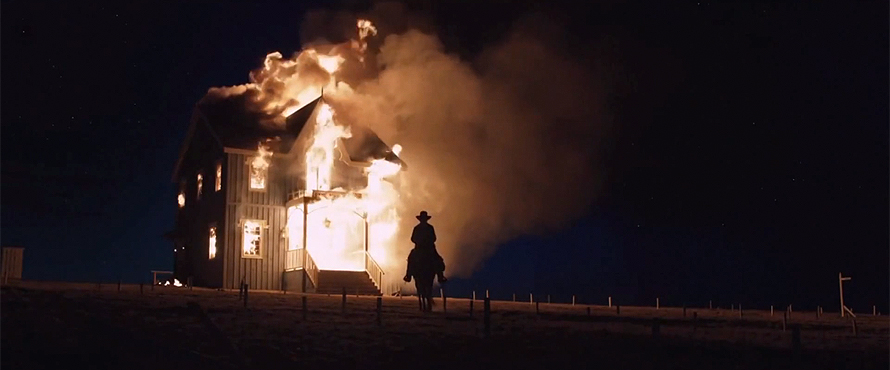
“THE HOMESMAN”
Director of Photography: Rodrigo Prieto, ASC, AMC
“The western is a very specific genre that I have never really liked too much, to tell you the truth. But this story is not your classic, let's say, western. It wasn't about shooting the landscapes or the vistas for me. It was more about the story of these women that I thought could be strong emotionally and visually. This is certainly a very important shot in the movie, but there were voices – and I won't say who – that wanted to take out that whole episode with the hotel because of the cost of it. Tommy Lee thought it was a very important scene for the character, when he goes back and exacts revenge. But it was nerve-wracking, of course, building this place and then burning it down!”
-Rodrigo Prieto
Some images make it to this list for largely aesthetic reasons. The first couple of entries on the collective this year are sort of in that realm, less interesting for thematic reasons than the feeling elicited by the sheer imagery they conjure or their composition. This particular frame from Tommy Lee Jones' “The Homesman” stood out for those reasons, sure – it's a dynamic, classic sort of image that feels like it belongs in the great takes of the western genre. But it also comes at a turning point for the main character, on the heels of his most aggressive act in the film, and so that iconography leaves you with a richer feeling, the hairs standing up on the back of your neck.
Rodrigo Prieto has dabbled in some of the western genre's elements in the past with “Brokeback Mountain,” still his only Oscar nomination to date. It was interesting to hear that it's not a genre of particular interest to him, however, as he seems to take to it very well. He's branching out as of late by collaborating with Martin Scorsese, which ought to be a treat for viewers when “Silence” rolls around in particular.
#9
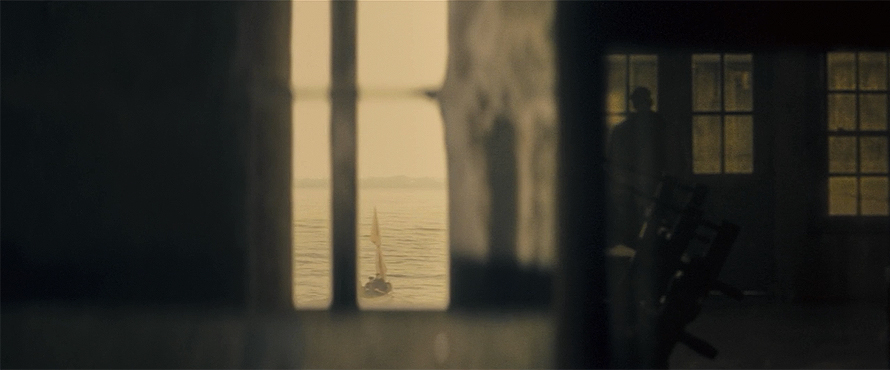
“THE IMMIGRANT”
Director of Photography: Darius Khondji, ASC, AFC
“This was completely generated by the wish, the desire, of James Gray. He wanted to do the shot this way. We couldn't find a location that was really right, though. Because of the location where we were, we could see the boat but we couldn't actually do the shot that way. We decided to do it in different passes, so we basically mixed different things. It was enhanced visually and we added the reflection. It's almost like a Tarkovsky shot. It's mixing all the different elements of the story, Marion and her sister going toward liberty and Joaquin's realization and redemption as a human being, that he can come to the light and realize he was wrong. It sums up the whole movie.”
-Darius Khondji
Not to make it sound dramatic, but I have had a bit of a complex relationship with this shot all year. First and foremost, Darius Khondji's work on “The Immigrant” made for some of the finest cinematography of 2014, evocative and gorgeous with a lot of thematic heft throughout. But the final image of the film didn't quite grab me like it did others, just because of the context of what's happening in the shot. It didn't seem to require that profound a visual commentary. And some of its impact even feels slightly diminished for me by the fact that it wasn't achieved without CGI.
I'm backhanding one of my selections, here, so let me quickly clarify. It does have thematic virtue, as Khondji lays out in the quote above. And it is an arresting composition, regardless of how one perceives that thematic virtue. I view it as a torch-bearer for Khondji's work throughout the film, really, a Neo-Realism/Caravaggio-influenced reminder that he has one of the most dynamic visual signatures of all his peers. He and director Woody Allen have a pretty solid partnership as of late but I would love him to collaborate with some other filmmakers, or perhaps even go back to the David Fincher well once more.
#8
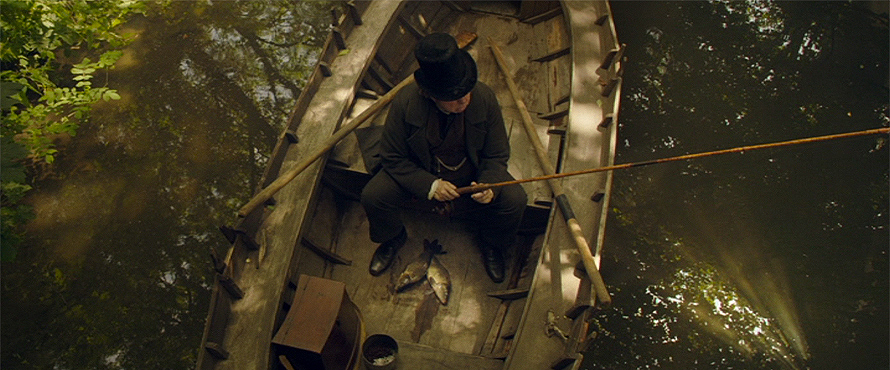
“MR. TURNER”
Director of Photography: Dick Pope, BSC
“It's like a still life. That was like an interlude shot that we picked up when we were in this location. I went off for a walk on this riverbank and discovered this quite magical area with sort of cathedral-like, covered willows and trees, very still. I shared it with Mike and we went there and there was beautiful sunlight. I got the guys to pump smoke in and smoke up the river, and then waited for it to settle so the beams of light were picked up. We went in and did some other shots of him sitting in the boat and then that one, which we did from a bridge looking down on him in the boat. And the art direction, like everything in these films, was meticulous. There was nothing to chance.”
-Dick Pope
A number of J.M.W. Turner's most famous works are virtually recreated with light and digital 1s and 0s by Dick Pope in Mike Leigh's striking biopic, from “The Fighting Temeraire” to “Chichester Canal” to “Snow Storm – Steam-Boat off a Harbour's Mouth.” But more than a few of the frames he conjures could themselves be hung in a gallery, and this one stood out the most for me, a bird's eye view of the man mourning the loss of a father.
Look at the precise design of the frame there, everything placed just so. Indeed, it's like a still life, as Pope says. I still sit in awe at the photography in this film, mouth agape particularly at the fact that it was a digital production. It's crisp and clean but still doesn't scream “digital” when the beauty of it all washes over you. Some of the best work of the year behind the camera. (For more, read our interview with Pope here.)
#7
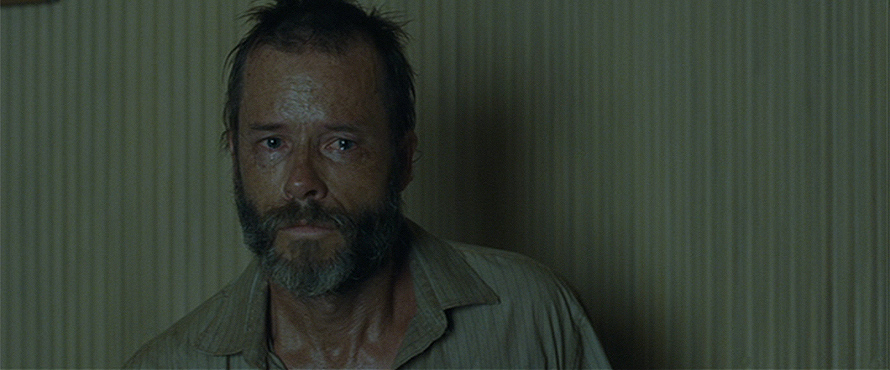
“THE ROVER”
Director of Photography: Natasha Braier, ADF
“We were trying to support this idea of Guy being a character who was difficult to penetrate and to see with the way we were framing him throughout the film. At the beginning, we always see him in back or turning – we're never really in front of him. He's always kind of hidden, because it's dark or he's standing near the darker areas of a room. As the film develops, we start to get more frontal and he gets more accessible and we start to see him more in the light. That shot is probably one of the only shots in the movie in which Guy has total front light lighting his whole face, and I think the reason why it's very powerful is it's kind of like the character becomes human in that moment.”
-Natasha Baier
I would probably call “The Rover” one of the best films you didn't see this year. OK, maybe you saw it, but obviously most didn't – it died a quick death at the box office. But it's a gorgeous movie, both photographically and thematically, and few shots this year drew a reaction out of me like this 60-second take of Guy Pearce releasing much of the pent-up emotion his character has kept buried throughout. I had a complex emotional response that built with every second of the shot and crescendoed with the single tear that eventually falls from his eye.
That's the kind of thing I look for with this feature every year. What grabbed me, not just superficially, but viscerally? There's a shot earlier in the film that is pretty creative and great, Pearce sitting at a bar as a vehicle violently crashes on the highway, the carnage quickly visible through the window behind him. It set up the visual style of the film by creatively displaying the story's inciting incident. Something like that is great. Something like this, however, is transcendent.
#6
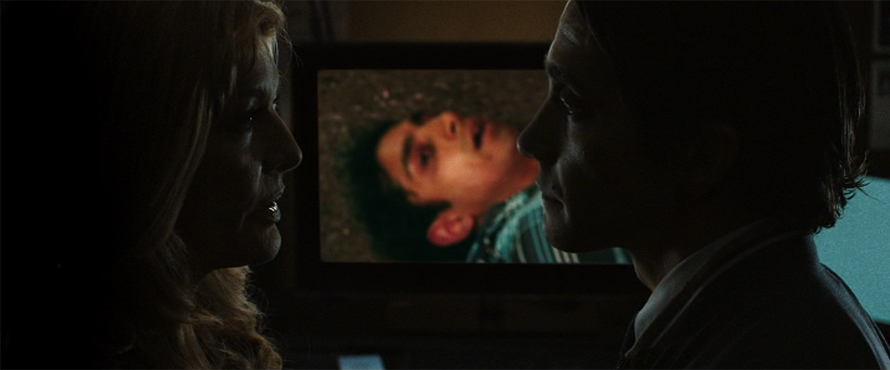
“NIGHTCRAWLER”
Director of Photography: Robert Elswit, ASC
“That really grew out of, 'Here we are, here's this shot,' and I think Danny and I just went, 'Wow. They're looking at each other. They're really in love,' or what? Whatever it is that's going on between the two of them! And it just seemed the perfect way to do it. You stand in a room and you watch rehearsal and it just rang a bell. 'That's it.' I don't think anyone will be able to make anything as prescient and brilliant as 'Network,' the demise of news, the turning of everything on television into entertainment. Paddy Chayefsky's script, he saw it all coming, and he knew what the forces were behind it. But this was a look at how cynical television is in a very sort of direct and honest way.”
-Robert Elswit
Robert Elswit absolutely crushed it this year. To date he's one of only two people to have shots from different films on the list (the other being Roger Deakins, both going way back to the inaugural 2007 edition), and – spoiler alert – you'll soon discover he's done it again. But let's talk about “Nightcrawler,” a digital/celluloid production that yielded a Los Angeles unlike anything seen on a big screen this side of Michael Mann's oeuvre. It's a seedy but slick world he and director Dan Gilroy represented, and a couple of intriguing shots stood out, no question.
Ultimately I settled on this one because it's just so bold and striking. Ambitious opportunist Lou Bloom stares into the eyes of desperate news head Nina Romina as the fruits of their labor – the image of Rick, Bloom's dying employee and a victim of his cold ruthlessness – sits frozen on a monitor between them. It's almost like Rick is looking right at them, appalled by their actions. Or is he looking at us, pleading with us to change the channel and take responsibility as consumers? A powerful frame. (For more, read our interview with Elswit here.)
Continue to part two and the top five shots of the year!
***


 Archives
Archives